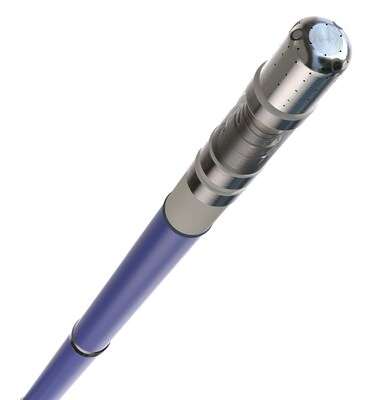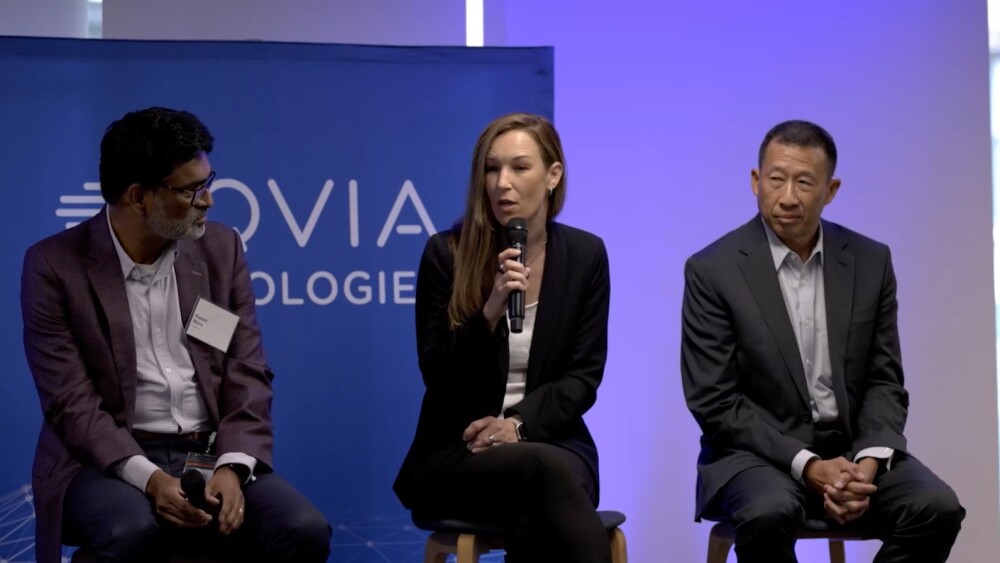Biosense Webster, Inc., a global leader in cardiac arrhythmia treatment and part of Johnson & Johnson MedTech, announced new findings from the Q-FFICIENCY study were published in the Journal of Cardiovascular Electrophysiology demonstrating treatment with the QDOT MICRO™ Catheter significantly improved control of atrial fibrillation, relief of symptoms and overall quality of life.
- Patients reported improvements of 99% in control of AFib and 93.1% relief of symptoms with the QDOT MICRO™ Catheter1
- Temperature control allows for the use of higher radiofrequency power in short bursts, enhancing efficacy and efficiency without compromising safety2
IRVINE, Calif., Nov. 2, 2023 /PRNewswire/ -- Biosense Webster, Inc., a global leader in cardiac arrhythmia treatment and part of Johnson & Johnson MedTech,i announced new findings from the Q-FFICIENCY study were published in the Journal of Cardiovascular Electrophysiology demonstrating treatment with the QDOT MICRO™ Catheter significantly improved control of atrial fibrillation (AFib), relief of symptoms and overall quality of life.1
Q-FFICIENCY evaluated the safety and 12-month efficacy of the novel QDOT MICRO™ Catheter temperature-controlled, contact force-sensing, radiofrequency (RF) catheter in patients with paroxysmal AFib.2
Based on patient-reported outcomes, the study found a 99% and 93.1% improvement in control of AFib and relief of AFib symptoms, respectively, at 12-month follow-up compared to baseline, and 87.9% of patients experienced a meaningful clinical improvement in quality of life.1
"These findings highlight the advantage of treatment with the QDOT MICRO™ Catheter in patients with paroxysmal AFib, demonstrating that patients have fewer symptoms and a significant improvement in their quality of life along with a low incidence of cardioversion and hospitalizations following temperature-controlled RF ablation treatment," said Ayman A. Hussein, MD, Director of Cardiac Electrophysiological Outcomes Research and Director of the Center for Atrial Fibrillation, Cleveland Clinic and the publication's corresponding author.ii "Paired with previously published Q-FFICIENCY study data showing that the unique design of the QDOT MICRO™ Catheter enhanced efficiency and efficacy without compromising safety, the benefit of treatment with this state-of-the art tool is clear for both patients and physicians."
The QDOT MICRO™ Catheter is a next-generation RF ablation catheter that incorporates advanced, high-energy ablation, improved temperature monitoring, optimized irrigation, and higher signal resolution. In QMODE+™ setting, the catheter allows the delivery of very high-power, short-duration ablation – 90 watts for up to four seconds, significantly improving ablation efficiency.2 The QDOT MICRO™ Catheter is fully integrated with the CARTO® 3 System, enabling efficient and consistent lesion creation with a simplified workflow and lower total procedure time.2 Earlier this year, Biosense Webster announced the publication of the Q-FFICIENCY safety and 12-month efficacy data in JACC: Clinical Electrophysiology, which showed that the QDOT MICRO™ Catheter delivered high clinical success with 86% of patients experiencing freedom from symptomatic recurrence while catheter-related primary adverse events remained low at 1.8%.2
"AFib places a substantial burden on patients' daily lives and healthcare resources, including physician visits, drug costs and side effects, and hospitalizations. At Biosense Webster, we are focused on improving patient outcomes, while offering innovative solutions for physicians treating the growing number of AFib patients today," said Jasmina Brooks, President, Biosense Webster, Inc. "As the Q-FFICIENCY study findings demonstrate, use of the temperature-controlled QDOT MICRO™ Catheter allows physicians to customize treatment for each patient, reduce procedural times and offer significant benefits to patients through improving their quality of life."
AFib is the most common type of cardiac arrhythmia affecting an estimated 37.5 million people globally.3 Responsible for more than 450,000 hospitalizations and nearly 5 million physician visits in the U.S. annually, AFib places a heavy burden on patients, their caregivers and healthcare systems.4 Despite these projections, many people are unfamiliar with AFib symptoms, available treatment options and the importance of early treatment to avoid disease progression.5 Catheter ablation is a safe and effective procedure to restore the heart's incorrect electrical signals, which causes an abnormal heart rhythm.6
About Q-FFICIENCY Study
In this prospective, multicenter, nonrandomized study, patients with drug-refractory, symptomatic paroxysmal AFib underwent PV isolation with the QDOT MICRO™ Catheter with very high-power short-duration as the primary ablation mode, which modulates power to maintain target temperature during 90 watt ablations for up to 4 seconds, with optional use of the conventional-power temperature-controlled mode (25 to 50 watts) for PV touch-up or non-PV ablation. The primary safety endpoint was incidence of primary adverse events within seven days of ablation. The primary effectiveness endpoint was freedom from documented atrial tachyarrhythmia recurrence and acute procedural, repeat ablation, and antiarrhythmic drug (AAD) failure. The primary safety and efficacy endpoints were met.
Patients' quality of life was assessed with the Atrial Fibrillation Effect on Quality-of-Life Tool (AFEQT), a questionnaire that measures symptoms, daily activities, treatment concerns and satisfaction at baseline and throughout 12 months following treatment with the QDOT MICRO™ Catheter.1
An 79.9% reduction in Class I/III AAD use was reported, with >50% of participants discontinuing all AADs postablation.1 Compared with the 12-month preablation period, the cardioversion rate decreased by 93.9% (P<0.0001) during the evaluation period.1 Hospitalizations were also low following ablation, with 80.9% (95% CI, 74.8%–86.9%) and 88.8% (95% CI, 84.0%–93.7%) Kaplan-Meier estimated 12-month freedom from all-cause and cardiovascular hospitalizations, respectively.1
About QDOT MICRO™ Catheteriii
The Biosense Webster QDOT MICRO™ Catheters and related accessory devices are indicated for catheter-based cardiac electrophysiological mapping (stimulating and recording) and, when used in conjunction with a compatible radiofrequency generator, for the treatment of:
- Type I atrial flutter in patients age 18 or older.
- Drug refractory recurrent symptomatic paroxysmal atrial fibrillation, when used with compatible three-dimensional electroanatomic mapping systems.
The Biosense Webster QDOT MICRO™ Catheters provide real-time measurement of contact force between the catheter tip and heart wall, as well as location information when used with CARTO® 3 Navigation System.
The QMODE™ setting is comparable to conventional RF ablation while using up to 50 watts for up to 60 seconds.2 The catheter has been designed to provide temperature control through intelligent adjustment of power and/or irrigation fluid output based on real-time temperature measurement; use of higher average RF power with QDOT MICRO™ Catheter is safely enabled by this precise temperature control.2
About Biosense Webster
Biosense Webster, Inc. is the global market leader in the science and technology behind the diagnosis and treatment of cardiac arrhythmias. Part of Johnson & Johnson MedTech, the specialized medical technology company is headquartered in Irvine, California, and works across the world to advance the tools and solutions that help electrophysiologists identify, treat, and deliver care. Learn more at www.biosensewebster.com and connect on LinkedIn and X, formerly Twitter.
About Johnson & Johnson MedTechi
At Johnson & Johnson MedTech,i we unleash diverse healthcare expertise, purposeful technology, and a passion for people to transform the future of medical intervention and empower everyone to live their best life possible. For more than a century, we have driven breakthrough scientific innovation to address unmet needs and reimagine health. In surgery, orthopaedics, vision, and interventional solutions, we continue to help save lives and create a future where healthcare solutions are smarter, less invasive, and more personalized.
Cautions Concerning Forward-Looking Statements
This press release contains "forward-looking statements" as defined in the Private Securities Litigation Reform Act of 1995 regarding data from one published study. These statements are based on current expectations of future events. If underlying assumptions prove inaccurate or known or unknown risks or uncertainties materialize, actual results could vary materially from the expectations and projections of Biosense Webster, Inc. and/or Johnson & Johnson. Risks and uncertainties include, but are not limited to: uncertainty of regulatory approvals; uncertainty of commercial success; challenges to patents; competition, including technological advances, new products and patents attained by competitors; product efficacy or safety concerns resulting in product recalls or regulatory action; changes to applicable laws and regulations, including global health care reforms; changes in behavior and spending patterns of purchasers of healthcare products and services; and trends toward healthcare cost containment. A further list and descriptions of these risks, uncertainties and other factors can be found in Johnson & Johnson's Annual Report on Form 10-K for the fiscal year ended January 1, 2023, including in the sections captioned "Cautionary Note Regarding Forward-Looking Statements" and "Item 1A. Risk Factors," and in Johnson & Johnson's subsequent Quarterly Reports on Form 10-Q and other filings with the Securities and Exchange Commission. Copies of these filings are available online at sec.gov, jnj.com or on request from Johnson & Johnson. None Biosense Webster, Inc. nor Johnson & Johnson undertakes to update any forward-looking statement as a result of new information or future events or developments.
© Johnson & Johnson Biosense Webster, Inc. 2023. All rights reserved. 260396-231019
|
_________________________ |
|||||||||
|
i Johnson & Johnson MedTech comprises the surgery, orthopedics, vision, and interventional solutions businesses within Johnson & Johnson's MedTech segment. |
|||||||||
|
ii Cleveland Clinic entered into a clinical trial agreement with Biosense Webster, Inc. for its participation in the Q-FFICIENCY Study. Dr. Ayman A. Hussein served as a study investigator and was not compensated for his contributions to this announcement. |
|||||||||
|
iii Important information: Prior to use, refer to the instructions for use supplied with this device for indications, contraindications, side effects, warnings and precautions. Caution: US law restricts this device to sale by or on the order of a physician. |
|||||||||
|
_________________________ |
|||||||||
|
1 Hussein A, Delaughter M, Monir G, et al. Paroxysmal AF Ablation With a Novel Temperature-controlled CF-sensing Catheter: Q-FFICIENCY Clinical and Healthcare Utilization Benefits. J. Cardiovasc. Electrophysiol. 2023 doi: 10.1111/jce.16093 |
|||||||||
|
2 Osorio J, Hussein A, Delaughter M, et al. Very high-power short-duration, temperature-controlled radiofrequency ablation in paroxysmal atrial fibrillation. J Am Coll Cardiol EP. 2023;9(4):468–480. doi: 10.1016/j.jacep.2022.10.019 |
|||||||||
|
3 Lippi G, Sanchis-Gomar F, Cervellin G. Global epidemiology of atrial fibrillation: An increasing epidemic and public health challenge. Int J Stroke. 2021;16(2):217-221. doi: 10.1177/1747493019897870. |
|||||||||
|
4 Tsao CW, Aday AW, Almarzooq ZI, et.al. Heart disease and stroke statistics-2022 update: a report from the American Heart Association. Circulation 2022;145:e153-e639. doi: 10.1161/CIR.0000000000001052. |
|||||||||
|
5 Kuck KH, Lebedev DS, Mikhaylov EN, et al. Catheter ablation or medical therapy to delay progression of atrial fibrillation: the randomized controlled atrial fibrillation progression trial (ATTEST). Europace 2021;23(3)362-369. doi: 10.1093/europace/euaa298 |
|||||||||
|
6 Natale, A. Reddy VY, Monir G, et al. Paroxysmal AF catheter ablation with a contact force sensing catheter: results of the prospective, multicenter SMART-AF trial. Journal of the American College of Cardiology, 2014;64(7),647–656. doi: 10.1016/j.jacc.2014.04.072 |
|||||||||
![]() View original content to download multimedia:https://www.prnewswire.com/news-releases/new-biosense-webster-qdot-micro-catheter-data-demonstrate-very-high-power-short-duration-ablations-improved-quality-of-life-and-reduced-healthcare-utilization-for-afib-patients-301975059.html
View original content to download multimedia:https://www.prnewswire.com/news-releases/new-biosense-webster-qdot-micro-catheter-data-demonstrate-very-high-power-short-duration-ablations-improved-quality-of-life-and-reduced-healthcare-utilization-for-afib-patients-301975059.html
SOURCE Biosense Webster, Inc.






